by Eric Meier
When attempting to identify a wood sample, it’s important to keep in mind the limitations and obstacles that are present in our task. Before starting, please have a look at The Truth Behind Wood Identification to approach the task in a proper mindset; I consider the linked article to be required reading for all those visiting my site with the intent of identifying wood.
1. Confirm it is actually solid wood.
Before proceeding too much farther into the remaining steps, it’s first necessary to confirm that the material in question is actually a solid piece of wood, and not a man-made composite or piece of plastic made to imitate wood.
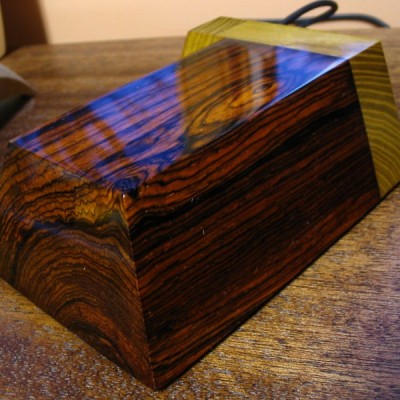
Can you see the end-grain?
Manufactured wood such as MDF, OSB, and particleboard all have a distinct look that is—in nearly all cases—easily distinguishable from the endgrain of real wood. Look for growth rings—formed by the yearly growth of a tree—which will be a dead-giveaway that the wood sample in question is a solid, genuine chunk of wood taken from a tree.
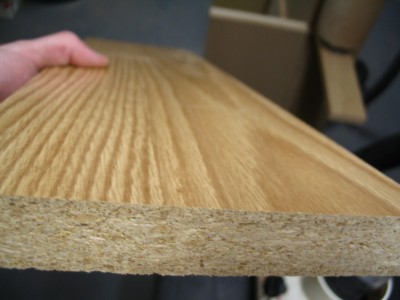
Is it veneered?
If you see a large panel that has a repeating grain pattern, it may be a veneer. In such cases, a very thin layer of real wood is peeled from a tree and attached to a substrate; sometimes the veneer can be one continuous repeating piece because it is rotary-sliced to shave off the veneer layer as the tree trunk is spun by machines. Assuming it is a real wood veneer with a distinct grain and texture—and not merely a piece of printed plastic—you may still be able to identify the outer veneer wood in question, but you should still realize that is it only a veneer and not a solid piece of wood.
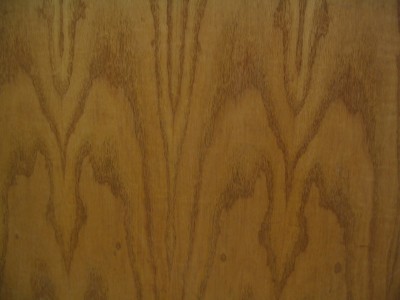
Is it painted or printed to look like wood?
Many times, especially on medium to large-sized flat panels for furniture, a piece of particleboard or MDF is either laminated with a piece of wood-colored plastic, or simply painted to look like wood grain. Many of today’s interior hardwood flooring planks are good examples of these pseudo-wood products: they are essentially a man-made material made of sawdust, glues, resins, and durable plastics.
2. Look at the color.
Some questions to immediately ask yourself:
Is the color of the wood natural, or is it stained?
If there is even a chance that the color isn’t natural, the odds are increased that the entire effort of identifying the wood will be in vain.
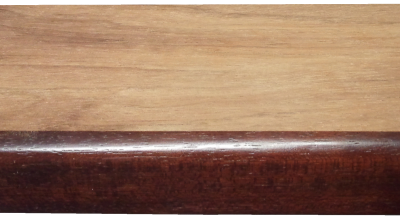
Is it weathered or have a patina?
Many woods, when left outside in the elements, tend to turn a bland gray color. Also, even interior wood also takes on a patina as it ages: some woods get darker, or redder, and some even get lighter or lose their color; but for the most part, wood tends to darken with age.
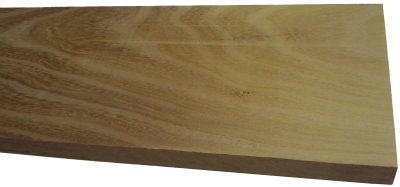
Is it possible to sand or plane the board to see the natural raw color of the wood?
The most predictable baseline to use when identifying wood is in a freshly sanded state. This eliminates the chances of a stain or natural aging skewing the color diagnosis of the wood.
3. Observe the wood grain.
If the wood is unfinished, then look at the texture of the grain. Ask yourself these questions:
Does the wood have an open, porous texture?
Most softwoods will be almost perfectly smooth with no grain indentations, while many common hardwoods have an open pore structure, such as oak or mahogany; though there are some hardwoods that are also smooth to the touch, such as maple.
Can you tell if the wood is quartersawn or plainsawn?
By observing the grain patterns, many times you can tell how the board was cut from the tree. Some wood species have dramatically different grain patterns from plainsawn to quartersawn surfaces. For instance, on their quartersawn surfaces, lacewood has large lace patterns, oak has flecks, and maple has the characteristic “butcher block” appearance.
Is there any figure or unusual characteristics, such as sapwood, curly or wild grain, burl/knots, etc.?
Some species of wood have figure that is much more common than in other species: for example, curly figure is fairly common in soft maple, and the curls are usually well-pronounced and close together. Yet when birch or cherry has a curly grain, it is more often much less pronounced, and the curls are spaced farther apart.
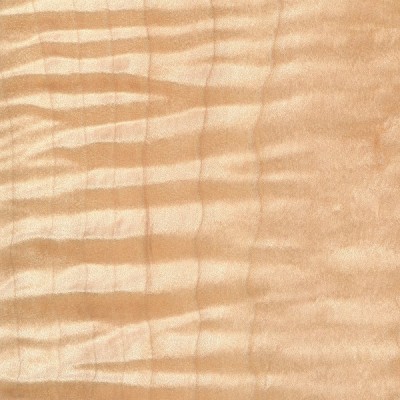
4. Consider the weight and hardness of the wood.
If it’s possible, pick the piece of wood up and get a sense of its weight, and compare it to other known wood species. Try gouging the edge with your fingernail to get a sense of its hardness. If you have a scale, you can take measurements of the length, width, and thickness of the wood, and combine them to find the density of the wood. This can be helpful to compare to other density readings found in the database. When examining the wood in question, compare it to other known wood species, and ask yourself these questions:
Is the wood dry?
Wood from freshly felled trees, or wood that has been stored in an extremely humid environment will have very high moisture contents. In some freshly sawn pieces, moisture could account for over half of the wood’s total weight! Likewise, wood that has been stored in extremely dry conditions of less than 25% relative humidity will most likely feel lighter than average.
How does the wood’s weight compare to other species?
Taking into account the size of the board, how does its weight compare to other benchmark woods? Is it heavier than oak? Is it lighter than pine? Look at the weight numbers for a few wood species that are close to yours, and get a ballpark estimate of its weight.
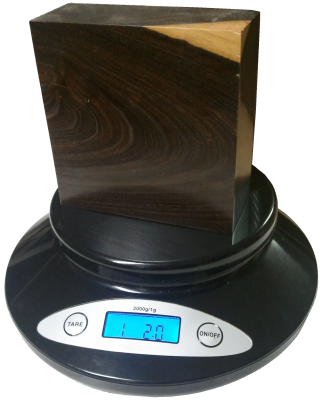
How hard is the wood?
Obviously softwoods will tend to be softer than hardwoods, but try to get a sense of how it compares to other known woods. Density and hardness are closely related, so if the wood is heavy, it will most likely be hard too. If the wood is a part of a finished item that you can’t adequately weigh, you might be able to test the hardness by gouging it in an inconspicuous area. Also, if it is used in a piece of furniture, such as a tabletop, a general idea of its hardness can be assessed by the number and depth of the gouges/dings in the piece given its age and use. A tabletop made of pine will have much deeper dents than a tabletop made of Oak. Additionally, you can always try the “fingernail test” as a rough hardness indicator: find a crisp edge of the wood, and with your fingernail try to push in as hard as you can and see if you’re able to make a dent in the wood.
5. Consider its history.
Many times we forget common sense and logic when attempting to identify wood. If you’ve got a piece of Amish furniture from Pennsylvania, chances are more likely that the wood will be made of something like black walnut or cherry, and not African wenge or jatoba. You might call it “wood profiling,” but sometimes it can pay to be a little prejudiced when it comes to wood identification. Some common-sense questions to ask yourself when trying to identify a piece of wood:
Where did it come from?
Knowing as much as you can about the source of the wood—even the smallest details—can be helpful. If the wood came from a wood pile or a lumber mill where all the pieces were from trees processed locally, then the potential species are immediately limited. If the wood came from a builder of antique furniture, or a boat-builder, or a trim carpenter: each of these occupations will tend to use certain species of woods much more often than others, making a logical guess much simpler.
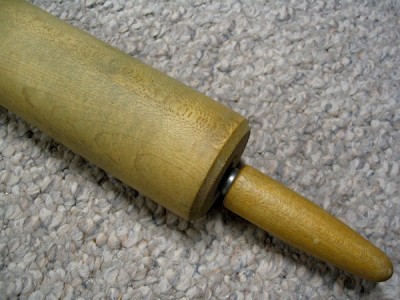
How old is it?
As with the wood’s source, its age will also help in identification purposes. Not only will it help to determine if the wood should have developed a natural patina, but it will also suggest certain species which were more prevalent at different times in history. For instance, many acoustic guitars made before the 1990s have featured Brazilian rosewood backs/sides, yet due to CITES restrictions placed upon that species, East Indian rosewood became a much more common species on newer guitars. (And this is a continuing shift as newer replacements are sought for rosewoods altogether.)
How large is the piece of wood?
Some species of trees are typically very small—some are even considered shrubs—while others get quite large. For instance, if you see a large panel or section of wood that’s entirely black, chances are it’s either painted, dyed, or stained: Gaboon ebony and related species are typically very small and very expensive.
What is the wood’s intended use?
Simply knowing what the wood was intended for—when considered in conjunction with where it came from and how old it is—can give you many clues to help identify it. In some applications, certain wood species are used much more frequently than others, so that you can make an educated guess as to the species of the wood based upon the application where it was used. For instance, in the United States: many older houses with solid hardwood floors have commonly used either red oak or hard maple; many antique furniture pieces have featured quartersawn white oak; many violins have spruce tops; many closet items used aromatic red cedar, and so forth. While it’s not a 100% guarantee, “profiling” the wood in question will help reduce the number of possible suspects, and aid in deducing the correct species.
6. Find the X-Factor.
Sometimes, after all the normal characteristics of a sample have been considered, the identity of the wood in question is still not apparent. In these instances—particularly in situations where a sample has been narrowed down to only a few possible remaining choices—it’s sometimes helpful to bring in specialized tests and other narrower means of identification.
The following techniques and recommendations don’t necessarily have a wide application in initially sorting out wood species and eliminating large swaths of wood species, but will most likely be of use only as a final step in special identification circumstances.
Odor
Believe it or not, freshly machined wood can have a very identifiable scent. When your eyes and hands can’t quite get a definitive answer, sometimes your nose can. Assuming there is no stain, finish, or preservative on or in the wood, quickly sand, saw, or otherwise machine a section of the wood in question, and take a whiff of the aroma.
Although new scents can be very difficult to express in words, many times the scent of an unknown wood may be similar to other known scents. For instance, rosewoods (Dalbergia spp.) are so named for their characteristic odor that is reminiscent of roses. Although difficult to directly communicate, with enough firsthand experience scents can become a memorable and powerful means of wood identification.
Fluorescence
While certain woods can appear basically identical to one another under normal lighting conditions, when exposed to certain wavelengths—such as those found in blacklights—the wood will absorb and emit light in a different (visible) wavelength. This phenomenon is known as fluorescence, and certain woods can be distinguished by the presence or absence of their fluorescent qualities. See the article Fluorescence: A Secret Weapon in Wood Identification for more information.
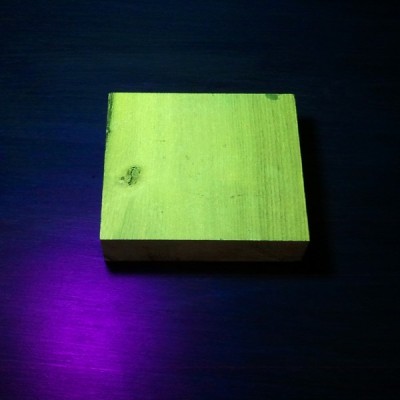
Chemical Testing
There are only a small number of chemical tests regularly used on wood, most of which are very specialized and were developed to help distinguish easily confused species with one another. They work by detecting differences in the composition of heartwood extractives. A chemical substance (called a reagent) is usually dissolved in water and applied to the wood surface: the surface is then observed for any type of chemical reaction (and accompanying color change) that may occur. Two of the most useful are the tests that are meant to separate Red and White Oak, and Red and Hard Maple.
Heartwood Extractives Leachability
Sometimes a wood species will have heartwood extractives that will be readily leachable in water and capable of conspicuously tinting a solution of water a specific color. For instance, the heartwood extractives contained in osage orange (Maclura pomifera) contain a yellowish-brown dye that is soluble in water. (This can sometimes be observed anecdotally when the wood is glued with a water-based adhesive: the glue’s squeeze-out is an unusually vibrant yellow.)
In a simple water extract color test, wood shavings are mixed with water in a vial, test tube, or other suitably small container, and the color of the water is observed after a few minutes. If the heartwood extractives are leachable by water, then a corresponding color change should quickly occur.
In addition to osage orange (Maclura pomifera), merbau (Intsia spp.), and rengas (Gluta spp. and Melanorrhoea spp.) are also noted for their readily leachable heartwood extractives. Because this property is quite uncommon, it can serve to quickly differentiate these woods from other lookalikes.
7. Look at the endgrain.
Perhaps no other technique for accurate identification of wood is as helpful and conclusive as the magnified examination of the endgrain. Frequently, it brings the identification process from a mostly intuitive, unscientific process into a predictable, repeatable, and reliable procedure.
Looking at the endgrain with a magnifier shouldn’t be a mystifying or esoteric art. In many cases, it’s nearly as simple as examining small newsprint under a magnifying glass. There are three components necessary to reap the full benefits contained in the endgrain:
I. A prepared surface.
When working with wood in most capacities, it becomes quickly apparent that endgrain surfaces are not nearly as cooperative or as easily worked as face grain surfaces. However, in this case, it is absolutely critical that a clear and refined endgrain surface is obtained.
For a quick glance of a softwood sample, a very sharp knife or razor blade can be used to take a fresh slice from the endgrain. However, in many denser species, especially in tropical hardwoods, one of the best ways to obtain a clear endgrain view is through diligent sanding. It’s usually best to begin with a relatively smooth saw cut (as from a fine-toothed miter saw blade) and proceed through the grits, starting at around 100, and working up to at least 220 or 320 grit, preferably higher for the cleanest view.
II. The right magnifier.
It need not be expensive, but whatever tool is used to view the endgrain should have adequate magnifying power. In most instances, 10x magnification is ideal, however, anything within the range of 8 to 15x magnification should be suitable for endgrain viewing. (Standard magnifying glasses are typically in the range of 2 to 4x magnification.)
These stronger magnifiers, sometimes called loupes, usually have a smaller viewing area than standard magnifying glasses. Fancier models—with built in lights, or larger viewing surfaces—are available at a premium; but the most basic models are usually only a few dollars.
III. A trained eye.
The third element that constitutes a proper endgrain examination is simply knowing what to look for. In analyzing the patterns, colors, shapes, and spacing of the various anatomical features, there is a veritable storehouse of information within the endgrain—all waiting to be unlocked. Yet, if these elements have not been pointed out and learned, the array of features will simply seem like an unintelligible jumble. The discipline of recognizing anatomical endgrain features is not easily summed up in a few sentences or even a few paragraphs, but it is nonetheless critical to the identification process. To this end, an in-depth look should be given to the various categories, divisions, and elements that constitute endgrain wood identification on the macroscopic level. (In this regard, macroscopic denotes what can be seen with a low-powered, 10x hand lens—without the aid of a microscope—rather than simply what can be seen with the naked eye.) Because the anatomy between softwoods and hardwoods is so divergent, each will be considered and examined separately:Still stumped?
If you have a mysterious piece of wood that you’d like identified, you’ve got a few options for next steps:USDA’s Forest Products Laboratory
You can mail your physical wood samples to the Center for Wood Anatomy Research.
Pros:
- Free
- Professional wood identification
Cons:
- Only available to US citizens
- Slow turnaround times (up to a month or more)
- Limited to three IDs per year
See their Wood ID Factsheet for more info.
Alden Identification Service
You can mail your physical wood samples (even small sections taken from antiques) to Alden Identification Service.
Pros:
- Professional wood identification
- Faster turnaround times (ranging from a few days to a week or two)
Cons:
- Paid service
See their ordering page for more info. (Note that Harry Alden has written several books while at USDA, including both Hardwoods and Softwoods of North America.)
Ask for help online
If the wood ID is merely a curiosity, or non-critical, you can post pictures of the wood in question.
Pros:
- Free
- No need to send physical samples
Cons:
- Greatly limited by the quality of the pictures provided
- Extra work usually required to get adequate clarity in photos
See article of Common US Hardwoods to help find the most commonly used woods.
Get the hard copy
 If you’re interested in getting all that makes The Wood Database unique distilled into a single, real-world resource, there’s the book that’s based on the website—the Amazon.com best-seller, WOOD! Identifying and Using Hundreds of Woods Worldwide. It contains many of the most popular articles found on this website, as well as hundreds of wood profiles—laid out with the same clarity and convenience of the website—packaged in a shop-friendly hardcover book.
If you’re interested in getting all that makes The Wood Database unique distilled into a single, real-world resource, there’s the book that’s based on the website—the Amazon.com best-seller, WOOD! Identifying and Using Hundreds of Woods Worldwide. It contains many of the most popular articles found on this website, as well as hundreds of wood profiles—laid out with the same clarity and convenience of the website—packaged in a shop-friendly hardcover book. 





Why I will no longer be replying to every wood ID request I’ve replied to literally thousands of wood ID requests on this site over the past 13+ years, but as the site’s popularity has grown, so has the time demands for ID on a daily basis. (Contrary to what some may seem to think, I am not some all-knowing wood wizard that can instantly ID your wood. It can actually take me a long time to sift through a lot of different resources.) Over the past few years, my backlog of pending wood species to be added to the… Read more »
Hello, this is a table I have that I will be sanding the stain off and refinishing. It is a soft wood I believe. I am wondering what colours this particular wood could have pulled through with specific stain (for example hickory with ebony)
Thanks
I have a veneer wood table that I have sanded down the top of and am wanting to stain. I’m curious about how the stain will show up depending on the type of wood and am wondering if you can tell what kind of wood this is on top? Took a close up picture of it
That looks like the wood still has residual stain in the pores. I’m going to guess it’s either oak or ash. It is a ring-porous hardwood, so it should take stain quite well. I would use the “oak” sample for reference when choosing a stain color.
Hi Eric, any clue on which type of wood my table might be??
Thanks you, Brad.
We are refinishing our kitchen cabinets. When sanded it is very smooth, the picture is sanded with varnish, no stain.. House built in 1980, in the PNW. Can you tell me what type of wood this is?
Looks like the sapwood and heartwood are both included, giving it a two-toned color.
I can’t tell from the picture, but some possible suspects might be maple, birch, or cherry. A few less likely candidates that are specific to the PNW would be madrone and myrtle.
Can anyone identify this wood? It’s a cutting board but I can’t figure out what kind of wood it is.
I am trying to figure out if this gateleg table is maple or walnut
Color definitely suggests walnut, unless it’s been stained. Can you get a closer picture of the grain?
Hello, could anyone tell me what type of wood this is? It’s a chest/end table that was owned by my grandmother.
If I had to make an educated guess, I would say it was a veneer top of mahogany crotch wood.
Thank you! :)
I’m working on refinishing my great-grandfather’s dining room table and could use some help in identifying the species of wood the top is made of. The table was made in the 1930’s but the species of wood is unknown to us. It has no distinct odor and is much heavier than a modern day table (but being solid wood that is to be expected). Any help is appreciated, thanks!
Looks like quartersawn white oak. Very nice ray fleck.
That there looks to be Tigers Oak veneer. The stripe pattern looks like tigers stripes, the end grain (side top) looks like the grain is going in and another direction than the top? Then it is veneer. Do not sand it if it is veneer.
Hi there,
Can anyone please identify what type of wood this is? You can see one section has been sanded right back.
Thank you!!
Hi does anyone know what wood this is?
It’s from a bannister in a Victorian house (circa 1880) London UK.
I’m taking the varnish off and refinishing. There is some damage I need to fill.
Looking for help Tim identify very old lumber
This appears to be rough sawn lumber belonging to my grandfather. It is very hard and heavy relative to oak or pine. It has be stored for 40- 50 years under a barn lean to. I did some sanding on one end and 2 adjacent sides
Can anyone help to identify this wood? The house was built in 1954. These are sold very thick planks. Than you.
Hi Deborah, I’m not a specilist but am a professional painter and finish quite a few different kinds of wood… To me the grain and color resemble either ” Cypress or Douglass fur” … Being said they both have a very distinct smell when cut.. I hope this helps????
Looks like Cypress or Douglass fur??? The smell after cutting or sanding will easily tell as they smell totally different. Hope this helps.?
Looks similar to the poderosa pine in my boyhood home.
Hello Everyone. I am looking to identify some wood on my great grandfathers barber box. It is the dark inlay in the middle that is obviously missing. I wood really appreciate the help. I know the box came from cuba, used/made in the 1930ish and I was told that it was Mahogany inlay, but when I look for it it does not look like Mahogany. Thanks for the help.
I was wondering if you could tell me what kind of wood this might be. This is the arm of a bamboo rocking chair.
Please help! Got this off of a pallet. After surfacing all the boards from all the pallets these are clearly different. They are heavier than the pine boards and it takes considerably more pressure to gouge with my finger nail. What type of wood is it?
What kind of floors have I found in my home that was built in 1914? These are the original floors as there is not a subfloor below them. TIA! I’m having a hard time sanding them down! This is a tough tough wood. Pulling the carpet staples out was a task in itself. We have several huge old walnut trees in our yard.
hi can anyone id this wood correctly for me I have notations on building its light walnut? anyone can positive id it I would be grateful, I have not been able to match them after kitchen remodel we bought some B&Q basic light oak hope is to stain them to marry them up cannot afford real wood not now I’m in wheelchair
Dear Eric, Thank you for your great DB and websites. It’s nice to meet a professional who knows his job perfectly and do it with love. Thank you again and God bless you!
Can anyone tell what kind of wood this bed frame is?
Hi. Any idea what type of wood this might be? It is a solid small table I got but it was painted so I sanded it down. There is a stunning smell on the wood when sanding it as well. Thanks so much.
If it smells like a sharpened pencil, it would most likely be Aromatic Cedar.
I’m not an expert but it looks like cedar to me, especially if it has a strong smell.
Is anyone able to identify the wood used in this chair? Thank you, in advance,for any clues!
Hello;
Can you Eric or can someone help me identify this piece?
I need to know in order to apply the right finish;
Many thanks.
Maybe this one will be easier to identify. Same wood, different angle.
That is Philippine Mahogany.
Did you get an answer? I’m looking at the same thing here.
Hi everyone, hi Eric;
any idea about this ? I have to figure out in order to put the right painting or whatever on it.
Thanks!
I have a Swiss knife who’s handle is made of wood. I wanted to know what kind of wood it is. A friend of mine says it’s probably ash wood because of the light color and how smooth it is without the use of a coating. If anyone could identify it for me I would appreciate it greatly
Victorinox web site says its Walnut.
I have a knife that a man put a new rosewood handle on it for me and it looks just like the wood in your knife.
Hi Eric, hi guys
Does anyone have any idea ?
This is a part of an outdoor stair railling and I need to know what it is made of in order to put the right painting or oil on it.
Thanks!
Hello ,
I have a old wooden frame and I cannot determine what kind of wood it is. I know 20 years ago it was worth $200. That’s all I know . Any help would be appreciated !
Can someone help me identify this?
I can’t see my last post, so I’ll try again with a different picture. Trying to identify this extremely hard wood said to be from India. Thanks!
Hi, folks. I bought this table from a “boutique”-type store near Salt Lake City 15 years ago that is no longer in business, and I’m trying to identify the wood. I was told it’s a wood from India, but that’s all I remember. It is extremely hard, has kept a beautiful sheen for all these years, and has a grain you can feel (smooth and not splintery at all). I’m moving and trying to decide which pieces I just can’t part with. Can anyone help?
From India maybe sheesham wood.
Eric,
I have a couple slabs of wood I cant identify. If Im guessing I say wild Cherry but the end grain is different than what you show as Wild Cherry. This wood is heavy and hard with tight growth rings. Any help identifying appreciated.
Im trying to find out what kind of wood this is it was found out in a barn stacked up in multiple pieces it’s very very hard very very strong I can barely indent it with a fingernail can anybody help me please
Looks like elm. Used for flooring in horse stalls and for wagon-wheels, because it’s very dent-resistant.
Just bought this stand today. All wood, marble top.
Now at home and checking for information on it on the internet I’m seeing that it might possibly be rosewood.
Information we were given indicates piece could be approximately 100 years old, or more. .??
What are your thoughts on type of wood?
Is the chair made of Oak? What do you think Eric
Could you tell me what type of wood this cabinet is made of?
Please can you assist me in identifying what wood this antique cot is made of
This wood was cut about 25 years ago from south Mississippi. Was told it was sassafras. It’s ectremely lightweight and has no smell.
Any idea what this is ?
Tiger maple maybe. We have several pieces of that running in the family, and it was always called tiger something.
Zebra wood or at least that is what it looks like to me maybe from the 1930’s today zebra wood furniture really likes to highlight the straight lines of the wood whereas yesteryears the more organic grains were used highlighting every quality of the wood. It could also be tiger oak but given the time of the piece of the spaces of the gains I wanna say zebra.
Looks like Tiger Oak to me.
This is quarter sawn oak which has been stained. suspect its re pro Edwardian.
Hi can anyone tell me what kind of wood this is? I bought it in Montana.
Trying to figure type of wood
Would anyone be able to tell me what this box is made from ?
Any idea as to the tree?
This looks exactly like a cherry burl I’m using. My vote is cherry!
Do you know what type of wood this is? Want to know best process to refinish.
I have the same bed frame and was wondering what type of wood it is made of. Also any chance you know the manufacturer? I got mine at an estate sale, so i don’t know the company that made it. Thanks
Hi guys!
Any idea what kind of wood on the picture?
Thanks!
Hi. They say that it’s mahoghany, but i doubt this is true. Maybe aghatis or something like that.
It could be mahogany, it’s not too uncommon to see it stained a very dark burgundy color like that.
Gibson SG is one example… However, I’m not saying that this is definitely mahogany.. The Gibson SGs were made of mahogany that was stained a dark cherry. To my eye? it looked just like that photo.
Hello! Please can you help me to identify the wood that my chairs are made of?
Thank you
Possibly Sissoo? Can’t tell for sure from the picture.
Thank you!
Does this pic help?
sheesham
Looks like Cypress.
That is Shesham (Indian Rosewood) very common in Indian furniture.
Eric, hope you can help me with this one. Purchased it two years ago, and I believe it is Mahogany. Can you tell by the picture?
Can’t tell too much from the picture, but the color doesn’t quite look right for mahogany. Possibly Avodire or Afrormosia?
Hello, we have this dining room table and 4 chairs we are going to try and sell. My husband got them used over 30 years ago. The wood is very solid and heavy and reminds me of the wood that was commonly used as waterbed frames. I think it is Walnut but wanted to see what you think.
It *might* be walnut, but I’m not entirely convinced. From the looks of it, I would say it it more likely to be a softwood like pine that’s been stained to match the color of walnut. https://www.youtube.com/watch?v=ExKj6uovn-M
Hey I just wanted down these mid century side tables. Any ideas on what type of wood it is?
Looks like a softwood plywood?
Anybody have an ideal of what kind of wood this chair is made from .
Looks like a Spruce Burl
Any ideas?
Looks a lot like american black walnut…